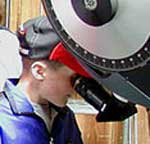Stargazing often intimidates beginners because the sky itself is so complex. Consider the following:
- The night sky is divided into 88 constellations, most of which are visible from the United States at different times of the year.
- On a clear, moonless night, a thousand or more stars are visible.
- Five of our solar system’s eight planets, a few star clusters, a spiral galaxy, and the odd bright comet are visible, too.
Truly, the catalog of objects visible to the unaided eye is impressive — and overwhelming.
 Bring the complexity down to earth
Bring the complexity down to earth
 Bring the complexity down to earth
Bring the complexity down to earthVeteran stargazers suggest that you begin your skywatching adventures indoors with a good skywatching guide or starchart. Every issue of StarDate magazine features monthly star charts and stargazing highlights. What to look for »
 Pick a good viewing spot
Pick a good viewing spot
Your own back yard will do just fine. Then, as you gain experience, escape from city lights into the darkness of the countryside. Find a state park or other safe, accessible spot. And try a night without moonlight, so you can see meteors and the Milky Way. Your checklist »
 Equipment
Equipment
The only instrument that most beginners need is their eyes. Our eyes can detect subtle variations in brightness, determine the colors and relative temperatures of stars, and track the motions of the Moon and planets. Equipment tips »
How does our view of the night sky change through the year?
As Earth moves along its orbit around the Sun, the night side of our planet faces in different directions at different times of the year.
In one day alone, the stars do not appear to have changed very much, but as the seasons change, the winter constellations of Orion and Canis Major are replaced in summer by the curling tail of Scorpius and the stars of the Summer Triangle.
This effect is strongest near the celestial equator; stars that are very nearly above or below the poles, such as the Polaris or the stars of the Big Dipper — so-called “circumpolar” stars, remain visible throughout the year.
Visit an observatory or star party
Many observatories offer public viewing nights on their research-grade telescopes, and we’ve compiled a list. Also, check out our coast-to-coast list of star parties and other astronomical events.